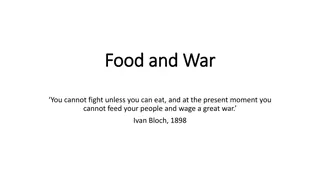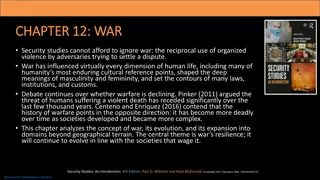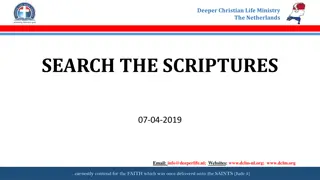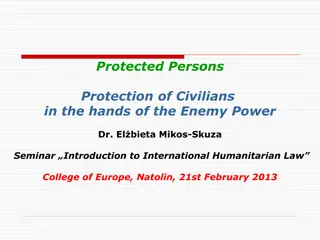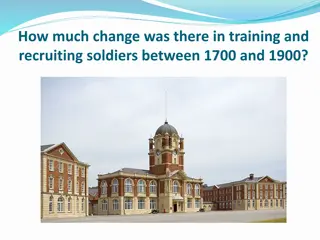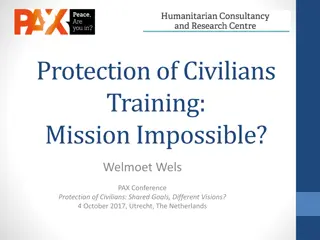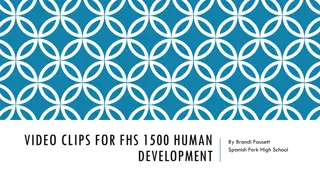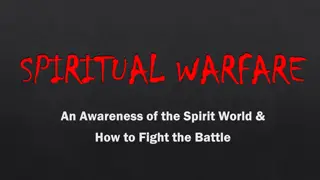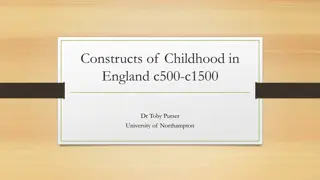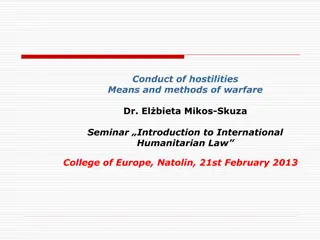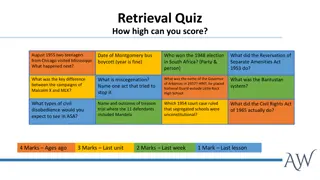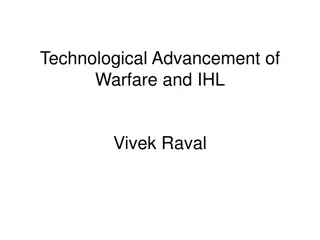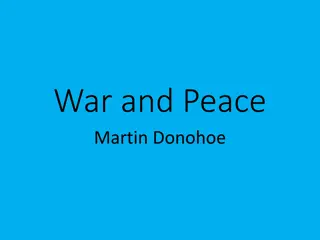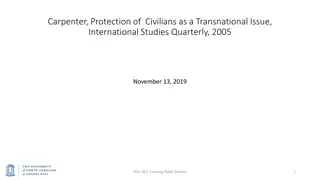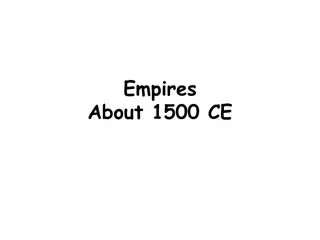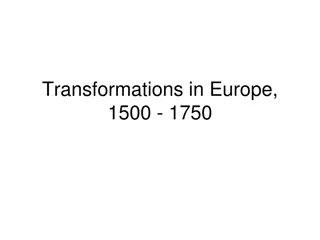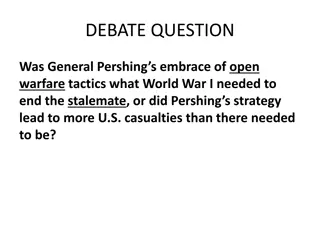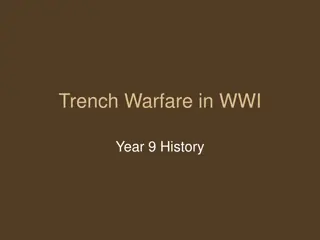Warfare Impact on Civilians Between 1500 and 1700
The impact of warfare on civilians between 1500 and 1700 varied, with factors like civilian deaths, recruitment, requisitioning, and taxation playing significant roles. While some regions experienced minimal impact due to lack of invasions, others faced challenges such as disruptions in trade, shortages, and increased taxation to fund military expenses. Recruitment led to a portion of the population serving in conflicts, with different wars seeing varying participation rates. Requisitioning of goods decreased over time with the development of purpose-built barracks, though some issues persisted. Overall, these factors shaped the experiences of civilians during this period.
Download Presentation

Please find below an Image/Link to download the presentation.
The content on the website is provided AS IS for your information and personal use only. It may not be sold, licensed, or shared on other websites without obtaining consent from the author.If you encounter any issues during the download, it is possible that the publisher has removed the file from their server.
You are allowed to download the files provided on this website for personal or commercial use, subject to the condition that they are used lawfully. All files are the property of their respective owners.
The content on the website is provided AS IS for your information and personal use only. It may not be sold, licensed, or shared on other websites without obtaining consent from the author.
E N D
Presentation Transcript
What was the impact of warfare on civilians between 1500 and 1700?
Learning objective to be able to identify changes and continuities in the impact of warfare on civilians between 1700 and 1900. I can explain the key changes continuities in impact of warfare on civilians between 1700 and 1900. Grade 6 I can explain and assess changes continuities in impact of warfare on between 1700 1900. Grade 9 I can describe the key changes and continuities in impact of warfare on civilians between 1700 and 1900. Grade 3 and and civilians and
How did warfare cause problems for the civilian population? Civilian deaths Recruitment Taxation Requisitioning Reporting Attitudes and opinion
Civilian deaths There were no invasions of England in this period and there was very little fighting on English soil too. Therefore, impact of fighting on civilians was minor. the direct
Recruitment The Militia Act was widely disliked and there were riots in 1757 when it was feared that militiamen were going to recruit men for the army abroad. Recruitment led to 10% of the male population serving in the Napoleonic Wars with a death toll of 2%. The Crimean War saw only 0.1% of the population fight. There was an increase in recruiting women to serve in the medical services abroad.
Requisitioning Requisitioning of goods and services at the demand of the Crown was an essential part of war. This significantly disrupted local trade and caused shortages. This declined in this period as the building of purpose built barracks took the need away from demanding goods and services from the population. The building of barracks was slow but rapidly increased during the Napoleonic Wars. Although, the need to billet soldiers in local inns and towns did continue and led to rowdy behaviour that upset the locals. The need for requisitioning fell further with the formation of the Land Transport Corps in 1855 which was responsible for transporting military items and the Army Service Corps in 1888 which specialised in the provision and movement of supplies.
Taxation This period saw the increase of taxation to help fund the increasing costs of supporting an army and navy. The costs of the army went up from 1 million in 1700 to 8 million in 1836. Although this was more intense in wartime. Income tax was introduced in the early 18th century. However the impact of rising taxation would be limited by the fact that the population boomed in this period so the burden of increased military costs would be shared by more people.
Reporting the wars the press The 19th century saw a boom in newspapers and reporting. There were more national newspapers with the increase of trains being able to transport them and over 500 local newspapers. The Crimean War was the first war to gain intense coverage. William Howard Russell of The Times being its leading war correspondent. He reported in graphic detail the course of the war, including criticisms and what went wrong. His reports were widely read and discussed. The Boer War continued this trend with over 300 correspondents reporting on the war.
Reporting the wars the electric telegraph The 19th century saw the invention of the electric telegraph. This enabled messages to be sent worldwide much faster. However, even short messages using the electric telegraph took days to be published and longer articles were still transported by boat and took even longer. For example the first article on the Charge of Light Brigade took 20 days to be published.
Reporting the wars photography The Crimean War was the first war to use photography to accompany reports. Roger Fenton was the main photographer of the war but chose to concentrate on living conditions rather than battle scenes. This was due to the nature of technology as well as an avoidance of upsetting civilians. However it was only from the 1880s that photographs could be used in newspapers and that more action shots could be taken.
Changing public opinion Increasing coverage of warfare impacted upon public opinion and made people more politically active in a number of ways The press gave the public a platform to write letters and discuss warfare- related issues. This led to governments becoming targets of criticism and challenge. The public helped to raise money for causes via the press - for example The Times set up a fund to help sick soldiers who served in The Crimean War. The public tried to make a practical contribution to the war effort, such as the mining industry in Leeds sent two locomotives for the railway in the Crimea.
Attitudes in society Increasing coverage of warfare impacted upon public in a number of ways Detailed reports boosted imperialism. Detailed reports encouraged jingoism. Detailed reports led to questioning of war as well and encouraged pacifism in areas of society.
Task Place these six impacts of warfare on civilians on a continuum which has at one end Little Change and at the other Big Change. Write a paragraph for each factor explaining your decision. Civilian Deaths Requisition Taxation Recruitment Reporting Attitudes and Opinion
Plenary My Brain Subheading My Brain Draw an outline of your brain. Fill your drawn brain with all the things you have learnt in this lesson. This can be in the form of key words, drawings, bullet points, lists anything you like so long as it summarises your learning and that others can understand it. http://www.download1.ch/wp-content/uploads/2013/03/Brain-Clip-Art-Vector-Download1.ch_-300x208.jpg http://www.illustrationsof.com/royalty-free-brain-clipart-illustration-1077577.jpg


